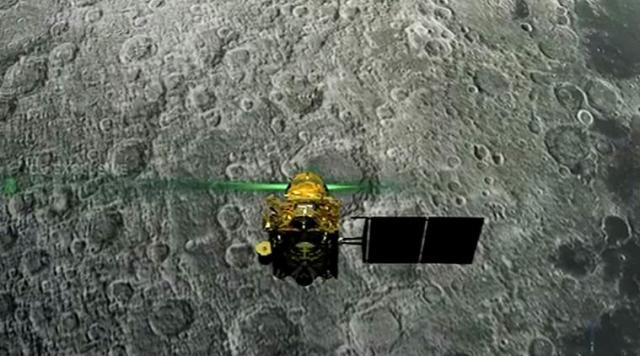
With less than three days to go before Sun sets over the area where the Vikram lander of Chandrayaan-2 mission fell off after a failed landing attempt, the Indian Space Research Organisation seems to have all but given up hopes of succeeding in its attempt to make contact with the spacecraft.
In a cryptic message posted on its Twitter handle, its first since September 10 when it had said attempts were still being made to restore contact with the lander, ISRO thanked everyone for standing by us .
We will continue to keep going forward propelled by the hopes and dreams of Indians across the world, it said, without giving any update on Vikram.
Officially, ISRO said there was no update to be shared. Any update or image would be shared on our website, it said in a message to The Indian Express. It said the tweet was meant to thank everyone who had encouraged ISRO.
But a source said an internal ISRO committee, constituted to go into the likely reasons for the failure in making the soft-landing, was likely to submit its findings very soon , possibly within the next couple of days. The source said the committee had met a few times and almost finalised its conclusions.
The report is expected to be made public in a few days after going through the proper channels, the source said.
Explained
Contact chances dim as lunar night nears
Attempts to restore contact with Vikram will become futile after two days, when a lunar night descends over the area where the lander currently is. Nights on the moon, which are equivalent to 14 earth days, can be extremely cold, with temperatures in the region where Vikram has landed expected to go down as low as -200 degree Celsius. The electronics on Vikram are not designed to withstand such low temperatures, and are likely to become non-functional.
Vikram, which was scheduled to touchdown on the Moon s surface on September 7, had deviated from its planned flight path when it was just 2.1 km above the Moon. From that point, it was not decelerating as fast it should have to enable a safe landing. A few seconds later, when it was barely 335 metres above the Moon, and travelling at more than 200 km per hour, it lost contact with the ground station. For a soft landing, Vikram needed to bring down its speed to less than 7 km per hour just ahead of touch down.
In subsequent statements, ISRO only said that it had lost contact with Vikram. A couple of days later, it said that the Chandrayaan-2 Orbiter, which is functioning normally and going around the Moon, had been able to locate the lander on the Moon and taken its thermal image . It has neither released thermal images nor said why normal images of Vikram were not taken. There are cameras on the Orbiter that can take normal optical images.

On Tuesday, the Lunar Reconnaissance Orbiter (LRO) of NASA, which has been going around the Moon since 2009, came over the location where Vikram landed. It would pass over that area several times as it continues in its orbit. The LRO is expected to take images of Vikram but it is not clear when these would be released.
A NASA official was quoted in the US media as saying that LRO images would be released at some time. Per NASA policy, all LRO data are publicly available. NASA will share any before and after flyover imagery of the area around the targeted Chandrayaan-2 Vikram lander landing site to support analysis by the Indian Space Research Organisation, a report in spaceflightnow.com, an online sources for space news, had quoted Noah Petro, LRO s project scientist at NASA s Goddard Space Flight Centre, as saying.








0 Comments